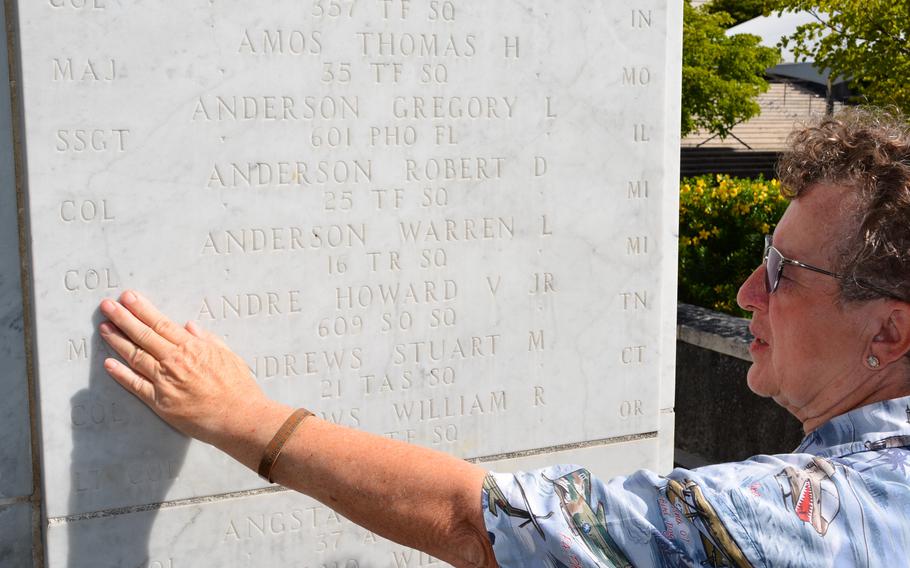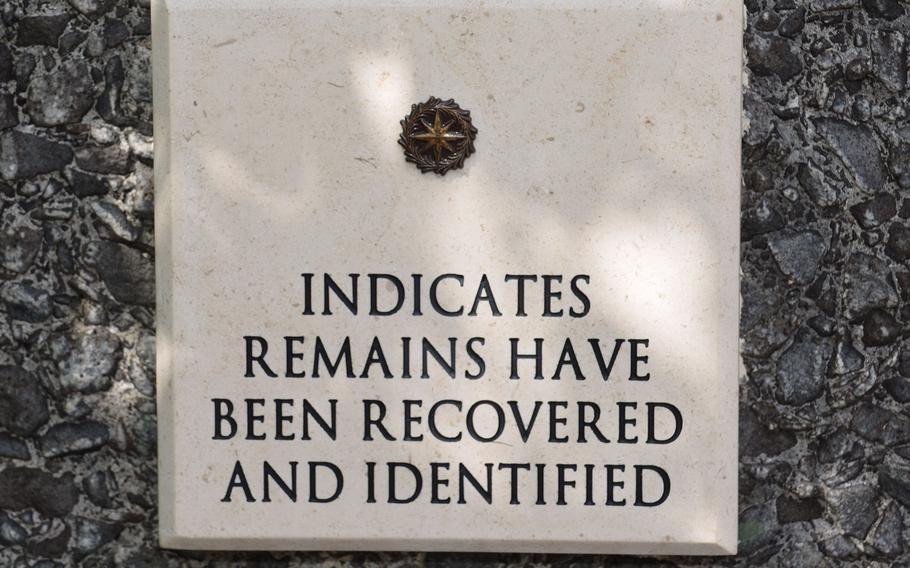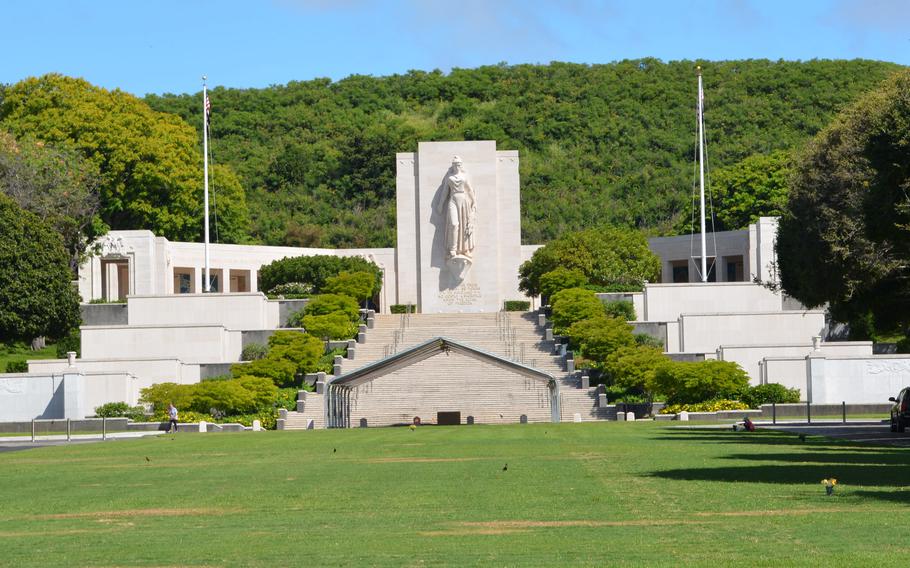
Natalie Rauch points to the name of her father, Col. Warren Anderson, etched in the marble at the Courts of the Missing in the National Memorial Cemetery of the Pacific on June 11, 2024. (Wyatt Olson/Stars and Stripes)
NATIONAL MEMORIAL CEMETERY OF THE PACIFIC, Hawaii — The daughters of two Air Force pilots who went missing during the Vietnam War are spearheading an effort to properly designate the status of names on the Courts of the Missing monument in Honolulu.
The monument’s looming marble walls list the names of all service members who went missing in the Pacific theater during World War II, the Korean War and the Vietnam War.
The American Battle Monuments Commission, which oversees the Courts of the Missing at the National Memorial Cemetery of the Pacific, attaches a bronze rosette beside the names of the missing whose remains have since been recovered and identified.
The two Vietnam War walls, erected in 1980, hold 2,504 names. The remains of more than 900 of those service members have been identified and accounted for since it was built, but only one rosette has been placed.
This fall, the Monuments Commission will hold a ceremony at the cemetery as it commences work on placing those overdue rosettes on the Vietnam War walls.
The ceremony was the brainchild of Colleen Shine and Natalie Rauch, the daughters of Vietnam War pilots killed in action.
Rauch, a longtime Hawaii resident, was 8 years old in 1966 when her father, Air Force Col. Warren Anderson, disappeared in the reconnaissance jet he was piloting over North Vietnam. His remains have not been found.
Shine, of Arlington, Va., was also just 8 when her father, Air Force Lt. Col. Anthony Shine, went missing in 1972 while flying a reconnaissance jet over the Laos border. His remains were identified in 1996.
Both have long been involved with the National League of POW/MIA Families and the U.S. Defense Department’s effort to locate and identify those still missing from the nation’s wars.
The Defense POW/MIA Accounting Agency, or DPAA, is the entity currently tasked with that work.

A placard at the Courts of the Missing at the National Memorial Cemetery of the Pacific in Honolulu displays an example of the bronze rosette that is placed beside the names of those whose remains have been recovered and identified. (Wyatt Olson/Stars and Stripes)
In early 2023, Shine, while on a trip to Oahu, joined Rauch for a visit to the Courts of the Missing to see her father’s name, Shine said by phone June 11 from her home.
“I thought I was going to see the American Battle Monuments Commission rosette that would indicate that he was accounted for,” Shine said.
But there was no rosette, nor were there any next to the many other names of accounted-for she had come to know over her years of involvement with families of the missing.
Later that summer, while Rauch was in Washington, D.C., for an annual briefing by DPAA for families of the still missing, the pair met with officials of the Monuments Commission, Shine said.
Out of that sprang the plan to hold a ceremony on Sept. 20. It will immediately follow the National POW/MIA Recognition Day ceremony held each year by DPAA.
“Everybody just stays in place,” Rauch said June 11 at the cemetery. “[The Monuments Commission] will have a much shorter ceremony to talk about the meaning of the rosettes.”

The walls of the Courts of the Missing stand on each side of grand steps at the National Memorial Cemetery of the Pacific in Honolulu. A pair of Vietnam War walls are at the forefront on each side. (Wyatt Olson/Stars and Stripes)
“We are hoping to have one representative family from each branch of the military to symbolically fit in a rosette during the ceremony,” she said. Shine will tap in a rosette next to her father’s name on behalf of the Air Force.
Other family members wishing to tap in a rosette can do so after the ceremony. Installation requires a pre-drilled hole in the marble.
Rauch said she and Shine have been contacting veterans service organizations, such as the VFW and Vietnam Veterans of America, to get the word out about the ceremony.
“We want to make sure that people know the event is happening, just in case they can send somebody,” she said.
Questions and requests for further information can be emailed to rosetteceremony2024@gmail.com.
Rauch and Shine both said they have chosen to concentrate on the ceremony rather than why rosettes were not installed in a timely manner.
The American Battle Monuments Commission did not respond to written questions submitted by Stars and Stripes.
“This is important to the families,” Shine said of placing the rosettes. “It’s important to honor my dad in that way.
“It’s also important to our Vietnam veterans, so that when they go to that memorial, they see that the honor due their fallen comrades has been bestowed.”